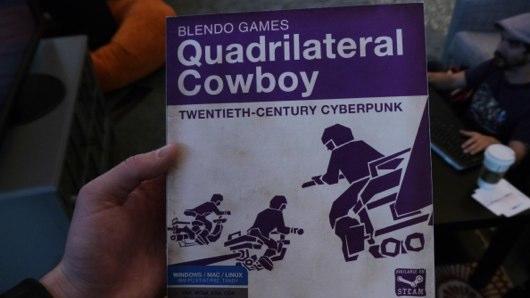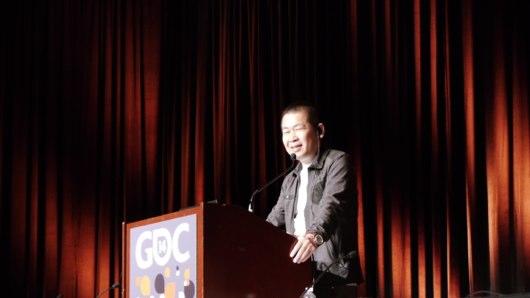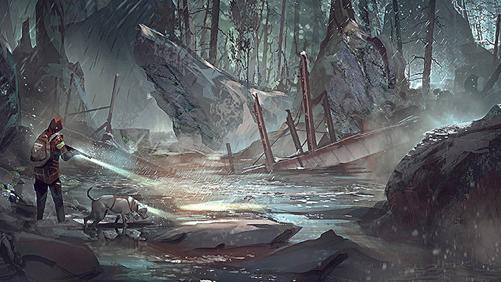gdc-2014
Latest

GDC 2014 round-up, Round Two: FIGHT!
The 2014 Game Developers Conference is wrapping up, and so, like Frodo and Sam making the long walk back from the mouth of Mt. Doom, so too must the Joystiq crew leave the mystical land of San Francisco. Oh well, at least we get to keep all our fingers. If you haven't already gotten caught up on all the GDC 2014 news, check out the first edition of our GDC round-up. It's chock-full of announcements, hands-on previews, features, dev talks and a special breakout for Sony's virtual reality headset, Project Morpheus. Done? Excellent. Kick back, grab a bowl of popcorn and let us regale you, young adventurers, of GDC 2014, and when Joystiq went there and back again.

Oink helps parents monitor and control their kid's in-app purchases
A 13-year-old with access to his parent's iTunes account can potentially rack up a sizable bill in an afternoon of Candy Crush -- a tab mom might potentially refuse to pay because she didn't authorize the purchase. Payments company Oink has created a solution that lets kids buy what they want, but still stay within mom and dad's budget. With the service, parents can tie a credit card to the account and set limits on exactly where funds in the account can be spent, as well as how much money can be used in a single purchase.

Former Leap Motion exclusive Blue Estate heading to PS4, more platforms
Blue Estate is switching the gesture controls of Leap Motion for the gyroscopic functions of the DualShock 4, after developer HeSaw revealed it's bringing the on-rails shooter to the PS4. HeSaw is showcasing the PS4 version at GDC this week, and revealed on Twitter it's bring the former Leap Motion exclusive to "more platforms to be announced soon." In our review of the Leap Motion version released last year, Jess Conditt gave Blue Estate two stars out of five. While Jess noted fans may enjoy a new way of experiencing the Image-published comic the game's based on, she said, "Blue Estate doesn't give its audience enough credit, assuming players will get a kick out of shooting enemies in the crotch, watching a strip show and making fun of how people look – assuming we'll forgive poor gameplay mechanics because the game is supposed to be crass." [Image: @BlueEstateTheGame]

Puppeteer director to pursue smaller games next, steer clear of retail
In a Puppeteer postmortem peppered with prickly punditry, Sony Computer Entertainment's Gavin Moore gave attendees of the Game Developers Conference a small idea of what he and his team hope to craft next. Coming off Puppeteer, a dark and clever PlayStation 3 platformer carved from the world of theater, Moore intends to pitch and pursue three to four smaller games beyond the borders of retail stores. "I think we're too reliant on stores to sell our products for us," Moore said. Though Puppeteer failed to find a large audience – "not a disaster by any way," he added – it seems to have spurred a serious rethink of retail, marketing and the backbreaking work of creating a unique and polished game. Moore intends to "make three or four products at once, and put them up on the net somewhere for people to download."

Take a tour of the History of Nintendo booth at GDC
If you're of a certain age or just an enthusiast of gaming's past, The History of Nintendo booth at this year's GDC is a veritable treasure trove of nostalgia. While other booths will have fancy-dan virtual reality devices of the future, this booth has the true master, the Virtual Boy, waiting to dazzle you with its red-and-black, headache-inducing charms. As for what's the most valuable thing there... perhaps that NES World Championships cartridge that's one of only 116 in existence? Or maybe it's that sparkly Nintendo 64 display if only because it's pure awesome. The booth, which was presented by The Video Game Museum and sponsored by GDC, had other classic gaming on display, including several standup arcade cabinets, a Sega Genesis and an Atari 2600 (complete with simulated wood-grain finish).

Seen@GDC 2014: The 1987 PC version of Quadrilateral Cowboy
Okay, we can't be sure this box for dystopian hacking game Quadrilateral Cowboy is actually from 1987, but it does boast about stunning SVGA graphics.

Two-player ballet with iOS, Android game Bounden
This is "the most elegant" Bounden dance routine that took place at GDC, according to Game Oven designer Adriaan de Jongh and producer Eline Muijres. Sure, they may say that to every person who grabs the other half of de Jongh's iPhone, but it still feels special. Bounden is a two-player game that uses a smartphone gyroscope to make players dance together. A reticle takes center stage on the phone screen, perched on top of a sphere. That sphere spins, bringing around lines of circles that have to match up with the reticle – with two players holding opposite ends of the phone, that means moving together in smooth, complex ballet moves. Bounden is made in collaboration with the Junior Company of the Dutch National Ballet – actual, professional dancers helped craft its moves, and it shows in the game's inherent grace. Take a look at some making-of videos here. Game Oven is committed to building mobile games that encourage physical interaction, as its previous titles (Fingle, Bam fu) demonstrate. The studio describes Bounden as a mix of Twister and ballet. Bounden is due out on May 21 for iOS and Android phones (not tablets, because that would be terribly inelegant). [Images: Joystiq, Game Oven]

Surviving hell in 11 Bit's This War of Mine
With its teaser trailer, This War of Mine presents a world ensnared in combat, but focuses its lens on the civilians caught in the middle of the brutal conflict. "In war, not everyone is a soldier," the ominous video notes, featuring huddled civilians within a building as uniformed soldiers battle outside. In part inspired by the mature message found in award-winning indie game Papers, Please and an article that recapped "One Year of Hell" within a besieged Bosnia, Senior Writer Pawel Miechowski says, This War of Mine is a bleak game about the repercussions of war and attempting to survive the chaos. In development at 11 Bit Studios, the team behind the Anomaly series, This War of Mine explicitly sets out of avoid the entertainment of firing a gun and scoring kills, Miechowski tells me. "This is a serious game. A mature game."
.jpeg.cf.jpg)
Tom Clancy's The Division 'never goes offline' during development
Ubisoft is currently promoting the visual and practical strengths of its "Snowdrop" engine, an always-on real-time development toolset built for Tom Clancy's The Division. Given the primary audience attending the Game Developers Conference, Ubisoft is focusing more on the engine than the post-apocalyptic nitty gritty of the game itself, which is being made for PC, PlayStation 4 and Xbox One. With The Division's progress and 2014 release being questioned in recent rumors, though, I asked Ubi-owned developer Massive Entertainment for some clarity on how it's being built. According to Rodrigo Cortes, Massive's Brand Art Director, "game and technology is the same," and it "never goes offline."

Tetropolis: the platformer starring Tetris pieces
It's weird to see tetrominoes – the boxy shapes we usually associate with Tetris – outside of their natural habitat. That's exactly what Tetropolis is about, though: a world obsessed with puzzle games, and the pieces that just aren't good enough. Tetropolis stars a defective tetromino (composed of only three squares instead of four) who joins forces with another defective piece (a single square) to avoid being destroyed. Working together, they can combine into various familiar tetrominos, each with different abilities. The line piece, for example, can scrunch its body like a spring and fling itself great distances. You use these abilities in an open world platforming game, which NextGen Pants lead Bob Webb describes as "Tetroidvania." In an interesting (and literal) twist, the map is composed of tetrominoes, which players can rotate to reshape the world and access new areas. We tried Tetropolis at GDC and, if nothing else, it's definitely novel. Tetropolis is currently planned for PC and Mac, and NextGen Pants is considering console ports as well.

Shenmue development bugs included cats walking like people and empty streets
Shenmue was an ambitious game for its time, incorporating a massive open world, environments full of people and activity and a complex combat system, all of which was delivered using state of the art graphics. It was a huge project and, as director Yu Suzuki revealed during the Shenmue postmortem panel at GDC 2014, it wasn't without some bizarre development bugs. In fact, up to 300 were found every day, according to Suzuki. Without some form of compression, said Suzuki (through interpreter Mark Cerny), all of the content in Shenmue would have required 50-60 CD-ROMs. As that would have been ... prohibitive to the average consumer, the Shenmue team had to come up with ways to save space, though this sometimes created unexpected results. Like cats walking on two legs.

Putting personality in pie charts with Metrico
Metrico is a platformer about bar graphs, pie charts, statistics and angles, asking players to repeat motions in order to shrink and grow their surroundings and advance through various vague landscapes. It's minimalistic and the presentation is concise – your character (a boy or girl) is a silhouette, and the surrounding objects are largely monotone. The build we played in August was rough, but almost one year on, the game is starting to round out. The animations are smooth, the puzzles border on frustrating difficulty without actually becoming a chore, and the game takes advantage of all of the Vita's senses. A fingertip on the back touch pad aims a line to measure angles, the bumpers shoot a projectile, and you use the touchscreen to select the gender of your character. Metrico feels like it's almost done, and Digital Dreams CEO Thijmen Bink says it might be ready for launch in a few months' time. The team has to polish the final levels and do one more, tiny thing: add a story.

Ouya dropping free-to-try requirement for developers in April
Currently, any game on the Android-powered Ouya microconsole must be free in some way, shape or form, be it a free demo or free to play business model. That situation is set to change next month, when the Little Console That Could drops its free-to-try requirement. Polygon reports that Ouya head of developer relations Kellee Santiago announced the shift at this year's Game Developer's Conference in San Francisco. "In response to developer feedback, in order to give more flexibility to game-makers to decide what content they want to make on Ouya, starting April we're making the free-to-try component optional," Santiago said. The Ouya team also announced that games "exclusive" to the Ouya can launch concurrently on PC as well, thanks to changes made in developer agreement deals. This follows the company's recent branching out, which will allow Ouya content on devices that are not an Ouya console. [Image: Ouya]

Overheard@GDC: Don't clone FTL, but...you know, make it better
FTL: Faster Than Light creators Justin Ma and Matthew Davis are a couple of mellow developers. Like, super chill. The pair are prepping to put a big red bow on FTL with the Advanced Edition and go on whatever journey comes next. Davis is contemplating doing a board game and Ma is looking to live in Japan and take it in. Although the pair wouldn't share sales numbers for FTL, Davis did say it was "enough for us to consider ourselves extremely lucky." The two devs have been waiting in the most positive way for games similar to their strategy sim to start creeping out at a regular pace. "I keep waiting for a knock-off! I want to play it," said Davis, looking at Ma. "Watch, by next week there's going to be like three clones," chimed in Ma. Davis exclaimed, "But it has to have multiplayer!" So, you know, if you're a developer making a game similar to FTL you've got at least two sales.

FTL: Advanced Edition shoots for $10 on iPad
FTL: Advanced Edition on iPad aims for parity with the desktop version, and it includes the full game plus the massive expansion hitting PC soon – and it will cost the same as the PC game, $10. Co-founders of FTL studio Subset Games, Matthew Davis and Justin Ma, recognize that for a mobile game, this is a "premium" price point. "Presumably the higher price point will make players a little bit more discerning on whether or not FTL will be something that they're interested in," Ma tells Joystiq at GDC. "Which is funny, because we're very expensive on iPad with the same price that's extremely cheap on PC. It could even be the same users that have the different perception of what is a $10 game, just based on the system." The Advanced Edition is a "pretty huge expansion," Ma says, and it adds polishing touches that Subset couldn't fit in the launch game, even though they wanted to. There's a new "Return to Stations" button that scatters the crew back to their set positions, and on iPad, you can drag a finger to select all workers and move them at the same time into one area, or drag to open a series of doors. Drag to change the levels of the energy bar in the bottom left corner, too. Davis says that one in particular feels really nice. One thing that didn't translate perfectly to the iPad is the dual-ship view. When your ship encounters another on PC they both populate the screen at the same size. On iPad, one is bigger, and you can change the dominant ship by tapping the one you want to inspect. Tap an attack action, and the enemy ship enlarges. "FTL works really well with the general way you play on iPad, just because you can pause it at any moment, come back later, and all the little events are bite-sized moments – " Ma says, and Davis adds: "You can do a jump and play that for two minutes – " Ma continues, "So that works out very well. And in that way, it's kind of casual, it's just you have to be able to put up with severe disappointment." FTL: Advanced Edition is due out "soon," the team says.

Ashen Rift: a man, his dog and the apocalypse
Barry Collins is a freelance artist and 14-year veteran of the video game industry who's been singlehandedly working on his passion project, Ashen Rift. During GDC he showed us a demo he put together in five months of the spartan post-apocalyptic survival shooter, which revolves around a man and his dog, Bounder. "You will seldom find enough ammo for any given situation, this forces the player to rely on Bounder to help you find useful objects and ammo," Collins told us. "You'll find yourself keenly aware of Bounder's state of mind as the whimpers and wines may be indicators of trouble nearby. Don't make too much noise. Don't waste ammo... and leave nothing useful behind." The game is currently on Kickstarter with a very reasonable $45,000 goal. Collins needs the money to pay for a Unity3D license, get some help with coding and music, with the end goal of the game being a "3 to 5 hour" experience on Mac, PC and Linux. If everything goes well, the game should be available by December 2014.

GDC 2014 round-up: All the stories, games and VR so far
The Game Developers Conference in San Francisco is going on now, and Joystiq is checking out every game, trying out every piece of new tech, walking every inch of the show floor, and eating every piece of pizza - yes, every piece - from the concession stands so that we can bring you the best news, interviews and previews. But we understand that not everyone can follow us every step of the way - people have jobs, families, secret evil lairs to construct, etc. - so we've prepared this handy little round-up to give you a summary of GDC 2014 so far. Prepare yourself. The fun cannot be halted.

Star Wars denied, creativity permitted: a crucial moment in LucasArts history
Founded in 1982 as a new division of George Lucas' entertainment empire, LucasFilm Games intended to hinge its products on cutting-edge technology. David Fox, also known as LucasArts Employee #2, envisioned a visually rich first-person spaceship game for Atari 8-bit systems – and doesn't that just sound perfect for Star Wars? "I wanted it to be a Star Wars game originally," Fox said, "and we were told right up front, when we asked, that we were not allowed to do Star Wars titles. "And I was really upset," he said, laughing. "I joined the company because I wanted to be in Star Wars and that was the closest way I could do it, to create a game and do it that way." Though LucasFilm Games would eventually align with Star Wars as it became the LucasArts we knew, it was this initial denial that set a course for long-lasting collaboration and unique design approaches. Speaking at the Game Developers Conference, in the first postmortem panel dedicated to a company, former figureheads spoke of an atmosphere in which creators were permitted to do anything but Star Wars. [Image: Guybrush Threepwood in Star Wars: The Force Unleashed 2 / Disney]

Meet BitBrawlers, a user-crafted multiplayer combat arena
Though it borrows a superficial structure from Super Smash Bros., upcoming indie multiplayer game BitBrawlers sets itself apart by giving players the ability to customize their combat. According to developer Tiny Build Games, BitBrawlers offers players the chance to customize abilities, weapons and even the environment they're fighting in. That trailer above demonstrates a few of these user-generated elements, though the process through which players build new elements for the game remains a mystery. That said, Tiny Build claims it built the above trailer in "an hour on the GDC showfloor," which suggests that the tools are easy to use once you've got a grasp on things. Tiny Build has yet to offer a solid release date for BitBrawlers, but plans to release the game to Steam at some point in 2014. [Image: Tiny Build Games]

Obsidian unleashes free-to-play tanks in Armored Warfare
Following the flatulence-laden release of South Park: The Stick of Truth, developer Obsidian Entertainment has revealed a new explosive game. Armored Warfare is the company's first foray into the wild world of free-to-play games and features modern tank battles. Armored Warfare is being published and distributed by Russia-based My.com, publisher and developer of free-to-play mobile games. The team-based PC title will feature player-vs-player and player-vs-environment gameplay and is expected to launch a closed beta sometime in 2014.






